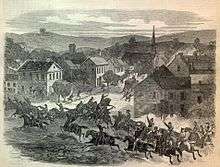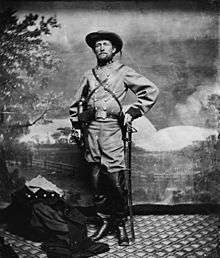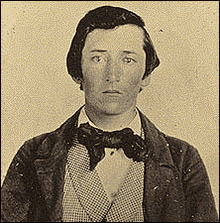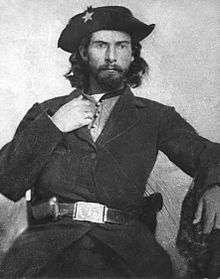Guerrilla warfare in the American Civil War
Guerrilla warfare in the American Civil War followed the same general patterns of irregular warfare conducted in 19th century Europe. Structurally, they can be divided into three different types of operations—the so-called 'People's War', 'partisan warfare', and 'raiding warfare'. Each has distinct characteristics that were common practice during the Civil War years (1861–1865).
Types of guerrilla warfare
The concept of a 'People's war,' first described by von Clausewitz in his classic treatise On War, was the closest example of a mass guerrilla movement in the era. In general during the Civil War, this type of irregular warfare was conducted in the hinterland of the Border States (Missouri, Arkansas, Tennessee, Kentucky, and northwestern Virginia / West Virginia). It was marked by a vicious neighbor-against-neighbor quality as other grudges got settled. It was frequent for residents of one part of a single county to take up arms against their counterparts in the rest of the vicinity. Bushwhacking, murder, assault, and terrorism were characteristics of this kind of fighting. Few participants wore uniforms or were formally mustered into the actual armies. In many cases, it was civilian against civilian, or civilian against opposing enemy troops.
One such example was the opposing irregular forces operating in Missouri and northern Arkansas from 1862 to 1865, most of which were pro-Confederate or pro-Union in name only. They preyed on civilians and isolated military forces of both sides with little regard for politics. From these semi-organized guerrillas, several groups formed and were given some measure of legitimacy by their governments. Quantrill's Raiders, who terrorized pro-Union civilians and fought Federal troops in large areas of Missouri and Kansas, was one such unit. Another notorious unit, with debatable ties to the Confederate military, was led by Champ Ferguson along the Kentucky-Tennessee border. Ferguson became one of the few figures of the Confederate cause to be executed after the war. Dozens of other small, localized bands terrorized the countryside throughout the border region during the war, bringing total war to the area that lasted until the end of the Civil War and, in some areas, beyond.
Partisan warfare, in contrast, more closely resembled commando operations of the 20th century. Partisans were small units of conventional forces, controlled and organized by a military force for operations behind enemy lines. The 1862 Partisan Ranger Act passed by the Confederate Congress authorized the formation of these units and gave them legitimacy, which placed them in a different category than the common 'bushwhacker' or 'guerrilla'. John Singleton Mosby formed a partisan unit that was very effective in tying down Federal forces behind Union lines in northern Virginia in the last two years of the war. Groups such as Blazer's Scouts, White's Comanches, the Loudoun Rangers, McNeill's Rangers, and other similar forces at times served in the formal armies, but often were loosely organized and operated more as partisans than as cavalry, especially early in the war.

Lastly, deep raids by conventional cavalry forces were often considered 'irregular' in nature. The "Partisan Brigades" of Nathan Bedford Forrest and John Hunt Morgan operated as part of the cavalry forces of the Confederate Army of Tennessee in 1862 and 1863. They were given specific missions to destroy logistical hubs, railroad bridges, and other strategic targets to support the greater mission of the Army of Tennessee. Morgan led raids into Kentucky as well. In his last raid, he violated orders by going across the Ohio River and raiding in Ohio and Indiana as well, as he wanted to bring the war to the northern states. This long raid diverted thousands of Union troops. He captured and paroled nearly 6,000 troops, destroyed bridges and fortifications, and ran off livestock. By mid-1863, Morgan's Raiders had been mostly destroyed in the late days of the Great Raid of 1863.
Some of his followers continued under their own direction, such as M. Jerome Clarke, who kept on with raids in Kentucky. The Confederacy conducted few deep cavalry raids in the latter years of the war, mostly because of the losses in experienced horsemen and the offensive operations of the Union army. Federal cavalry conducted several successful raids during the war but in general used their cavalry forces in a more conventional role. A good exception was the 1863 Grierson's Raid, which did much to set the stage for General Ulysses S. Grant's victory during the Vicksburg Campaign.
Union countermeasures against the Confederate guerrillas
Federal counter-guerrilla operations were successful in reducing the impact of Confederate guerrilla warfare. In Arkansas, Federal forces used a wide variety of strategies to defeat irregulars. These included the use of Arkansas Unionist forces as anti-guerrilla troops, the use of riverine forces such as gunboats to control the waterways, and the provost marshal's military law enforcement system to spy on suspected guerrillas and to imprison those captured. Against Confederate raiders, the Federal army developed an effective cavalry themselves and reinforced that system by numerous blockhouses and fortification to defend strategic targets.
However, Federal attempts to defeat Mosby's Partisan Rangers fell short of success because of Mosby's use of very small units (10–15 men) operating in areas considered friendly to the Rebel cause. Another regiment known as the "Thomas Legion", consisting of white and anti-Union Cherokee Indians, morphed into a guerrilla force and continued fighting in the remote mountain back-country of western North Carolina for a month after Robert E. Lee's surrender at Appomattox Court House. That unit was never completely suppressed by Union forces, but voluntarily ceased hostilities after capturing the town of Waynesville, North Carolina, on May 10, 1865.
Prolonging the war through guerrilla action
In the late 20th century, several historians focused on the Confederate government's decision to not use guerrilla warfare to prolong the war. Near the end of the war, there were those in the administration who advocated continuing the southern fight as a guerrilla conflict. These efforts were opposed by Confederate generals such as Lee who ultimately believed that surrender and reconciliation were the best options for the war-ravaged South.
Notable Civil War guerrillas, partisans, jayhawkers, and rangers


"Tinker Dave" Beatty and Dr. Hale
USA





M. Jerome Clarke, aka "Sue Mundy"
CSA



Jesse James and Frank James
CSA
Cole Younger
CSA
Jim Younger
CSA
Other notable bushwhackers, jahawkers, and guerrillas of the Civil War included Frank James, Jesse James, "Tinker Dave" Beaty,[1] Archie Clement, Silas M. Gordon, Champ Ferguson, Charles R. Jennison, James Montgomery, Joseph C. Porter, and George M. Todd.
See also
- Bushwhackers - (Confederate)
- Jayhawkers - (Union)
- Partisan rangers - (Confederate)
References
- ↑ Bryant, Lloyd D. "David "Tinker Dave" Beaty - (L2)." History of Fentress County, Tennessee. The Fentress County Historical Society.
Further reading
- Beckett, Ian Frederick William. Encyclopedia of guerrilla warfare (ABC-Clio, 1999)
- Beilein Jr., Joseph M., and Matthew C. Hulbert, eds. The Civil War Guerrilla: Unfolding the Black Flag in History, Memory, and Myth (Lexington: University Press of Kentucky, 2015) 243 pp
- Browning, Judkin. Shifting Loyalties: The Union Occupation of Eastern North Carolina (Univ of North Carolina Press, 2011)
- Fellman, Michael. Inside War: The Guerrilla Conflict in Missouri During the American Civil War (Oxford University Press, 1989)
- Gallagher, Gary W. "Disaffection, Persistence, and Nation: Some Directions in Recent Scholarship on the Confederacy." Civil War History 55#3 (2009) pp: 329-353.
- Grant, Meredith Anne. "Internal Dissent: East Tennessee's Civil War, 1849-1865." (thesis 2008). online
- Mackey, Robert R. The Uncivil War: Irregular Warfare in the Upper South, 1861-1865 (University of Oklahoma Press, 2014 reprint)
- Mountcastle, Clay. Punitive War: Confederate Guerrillas and Union Reprisals (University Press of Kansas, 2009)
- Nichols, Bruce, Guerrilla Warfare in Civil War Missouri, McFarland & Co. Inc., 2006. ISBN 0-7864-2733-7.
- Sutherland, Daniel E. A Savage Conflict: The Decisive Role of Guerrillas in the American Civil War (Univ of North Carolina Press, 2009)
- Williams, David. Bitterly Divided: The South's Inner Civil War (The New Press, 2010)
Primary sources
- U.S. War Department, The War of the Rebellion: A Compilation of the Official Records of the Union and Confederate Armies, 70 volumes in 4 series. Washington, D.C.: United States Government Printing Office, 1880-1901.
- Lowell Hayes Harrison, James c. Klotter, A New History of Kentucky, Lexington, KY: University Press of Kentucky, 1997
External links
- "Guerilla Warfare in Kentucky" — Article by Civil War historian/author Bryan S. Bush